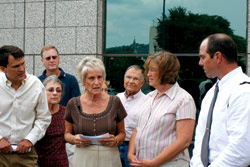Time is not on Dot Rice's side.
On a gray day in June, she stood in the shadow of the Federal Building and voiced her disappointment that Gov. Bev Perdue hadn't made time to meet with her during an Asheville visit. "My family's still in danger," said Rice. For decades, they've lived near the contaminated CTS site off Mills Gap Road.

And for years, they unknowingly drank well and spring water contaminated with trichloroethylene and other toxins attributed to the Elkhart, Ind.-based electroplating business, which operated an Asheville plant from 1959 to 1986. Rice and her husband still live adjacent to the site, her father-in-law once did, and her son lives in his old house, "practically on top of" a contaminated stream, she said.
TCE is a suspected carcinogen that, when inhaled in small amounts, can cause headaches and respiratory problems. Ingesting it can cause liver and kidney damage, impaired immune-system function and impaired fetal development in pregnant women, according to the Agency of Toxic Substances and Disease Registry.
Rice's father-in-law drank the spring water from the 1960s until his death in 1982 of esophageal cancer, she reported. Her husband, who drank their well water from 1974 to 1999, is recovering from a brain tumor (the family home was switched to city water after samples taken in 1999 showed TCE levels thousands of times higher than the allowable limit for drinking water). Her son, whose home tested positive for noxious vapors attributed to the contamination, suffers from several health problems that Rice believes are linked to TCE and other contaminants that were found on-site and in nearby water sources as early as 1991 (see "Fail-safe?" July 11, 2007, Xpress).
Rice herself, meanwhile, has had thyroid cancer, with one tumor removed not long before her June 18 press conference. "I may never talk again," she said in a hoarse whisper. "This contamination needs to be cleaned up."
And though CTS installed a vapor-extraction system near her son's house that has removed about 6,000 pounds of TCE, she isn't satisfied with what she and other affected residents see as years of dodging and delays by state and federal officials, as well as CTS and the property's current owners, Mills Gap Road Associates. Rice called the vapor-extraction system, which employs ozone to destroy the TCE fumes rising out of the stream, a "decoy" that's aimed at pacifying her family.
According to a 2001 Environmental Protection Agency memo, the highest concentration of the contamination apparently lies in the soil near buildings located at the heart of a roughly 57-acre industrial site. In 2002, the EPA called it an imminent hazard and ordered CTS to clean it up, yet little has been done, said Rice. Most recently, the state Department of Environment and Natural Resources has proposed an administrative agreement spelling out the parameters of a voluntary cleanup process while capping the company's total cost at $3 million: "CTS should be the one to clean up [the site] and bear the [full] expense," said Rice.
She and other concerned citizens submitted a 3,000-signature petition urging the state to reject the agreement, and the Buncombe County commissioners sent the governor a letter asking her to intervene and support that request, Rice continued. "This has been going on for 23 years, and I'm sick and tired of it. It's time something was done."
According to a June update by officials, the state's decision on the proposed agreement is pending. So is a review of the health problems residents attribute to the contamination. A study is also under way to determine if TCE found in wells at the nearby Oak Forest subdivision is linked to the CTS site. As for the Rice family, they're looking into the possibility of getting federal assistance to relocate the son.
Still, Rice says she remains very frustrated with the lengthy process. "If we don't keep after them, they won't do anything," she asserts. Since the first tests were spurred by a concerned citizen's call back in 1990, the toxins have continued to spread, Rice points out, saying, "They need to address the contamination under the [old] building."
Vapors still come up at the springs downhill from there, she notes. "Rains seem to make it worse. It's a distinctive smell — an oily, moldy, sort of a smoky smell as you walk toward the spring." And despite the lack of tone in her hoarse voice, there is strength in it when she adds, "It just doesn't seem like our country would let something like this go on for more than 20 years."
Send your environmental news to mvwilliams@mountainx.com or call 251-1333, ext. 152.





Before you comment
The comments section is here to provide a platform for civil dialogue on the issues we face together as a local community. Xpress is committed to offering this platform for all voices, but when the tone of the discussion gets nasty or strays off topic, we believe many people choose not to participate. Xpress editors are determined to moderate comments to ensure a constructive interchange is maintained. All comments judged not to be in keeping with the spirit of civil discourse will be removed and repeat violators will be banned. See here for our terms of service. Thank you for being part of this effort to promote respectful discussion.